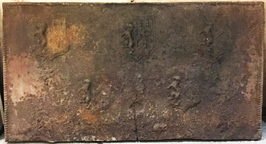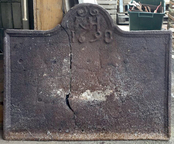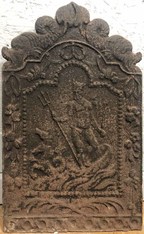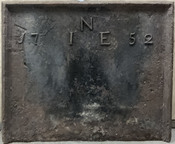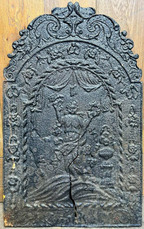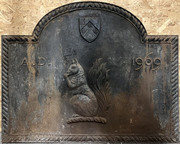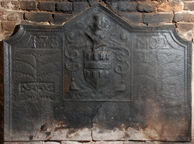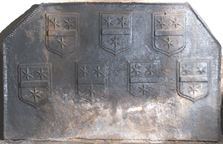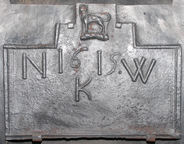-
1066
Description: Rectangular; twisted rope edging (top and sides only); five shields of Ayloffe impaling Sulyard in two rows, 3-2; Ayloffe: sable, a lion rampant Or, collared gules, between three crosses formy of the second; Sulyard: argent, a chevron gules between three pheons inverted sable.
Notes: William Ayloffe (c1535-1584) of Bretons, Hornchurch, Essex, Justice of the Court of Queen’s Bench, married (c1560) Jane, dau. of Sir Eustace Sulyard, of Runwell, Essex.
Arms: Ayloffe impaling Sulyard (William Ayloffe of Bretons, Hornchurch)
- Decoration tags:
- rectangular (shape)
- rope (edging)
- carved stamps
- heraldic
- armorial
Manufactured: in the early-17th century in the Weald area of England.
Current location: not known.
- Attached to series:
- Ayloffe series
- Personal armorial firebacks
-
1238
Description: Arched rectangular shaped, the arch linked to the rectangle by cavetto curves; cavetto edging ending in two opposed spirals at top; initials below spirals; date below initials; otherwise plain.
Notes: Probably cast from a carved, edged board, with the initials and date added separately. A copy of an earlier casting.
Inscription: RH / 1698
- Decoration tags:
- rectangular with round arch (shape)
- carved stamps
- individual letters
- individual numbers
- text
Manufactured: in 1698 in the Weald area of England.
Current location: Authentic Reclamation, Lymden Lane, Ticehurst, East Sussex, England.
- Attached to series:
- Small arch series
- Date & initials firebacks
-
1224
Description: Arched rectangular shaped central panel with canted, concave top corners and bead edging; naked, crowned figure of Neptune holding a trident in his right hand, standing amid waves and with two hippocampi to his right; same-shaped border with fillet edging and suspended ribbons with floral bunches; at base, symmetrical reeds tied with ribbon; base panel with nine linked rings; symmetrical serpents on top.
Notes: Other firebacks have the same distinctive central panel and border shape, suggesting the same pattern maker.
- Decoration tags:
- 'Dutch' (shape)
- fillet (edging)
- whole carved pattern
- pictorial
- mythological
- animals
- objects
Manufactured: in the early-18th century possibly in the Weald area of England.
Current location: not known.
- Attached to series:
- Mayfield 'Dutch' series
- British 'Dutch' style firebacks
-
1249
Description: Rectangular; bold ovolo-moulded edging (top and sides); at top, date widely split by initials in triad.
Notes: Characteristic lettering and numerals of the mid-18th century. The triad of initials probably refer to a husband and wife, the central initial N being that of their surname.
Inscription: 17 INE [triad] 52
- Decoration tags:
- rectangular (shape)
- ovolo (edging)
- carved stamps
- individual letters
- individual numbers
Manufactured: in 1752 possibly in the Weald area of England.
Current location: Authentic Reclamation, Lymden Lane, Ticehurst, East Sussex, England.
- Attached to series:
- Date & initials firebacks
-
1130
Description: Arched rectangular central panel with helical ribbon edging; pictorial image of a partially clothed female figure, holding an upraised wreath in her left hand and a garland in her right hand, standing on a ground, with a gadrooned vase containing flowers and leaves to the right and, above, swagged drapery; arched rectangular fillet border with descending leaves and flowers suspended from a wreath, top centre, and a wreath in each top corner; on top, mirrored swirled fronds terminating in the heads of sea monsters; bottom, vestiges of SHR monogram otherwise all decoration obliterated by fire damage.
Notes: The figure is an allegorical representation of Agriculture, one of the Iconologia originally published by Cesare Ripa in 1613.
Copies of this fireback are known.
Inscription: SHR
- Decoration tags:
- 'Dutch' (shape)
- fillet (edging)
- whole carved pattern
- allegorical
- text
- humans
- plants
- objects
Manufactured: in the early-18th century in England.
Current location: Authentic Reclamation, Lymden Lane, Ticehurst, East Sussex, England.
- Attached to series:
- Agriculture firebacks
- SHR series
- British 'Dutch' style firebacks
-
1257
Description: Arched rectangular shape, edged with simulated twisted rope between two fillets; in the arch, a shield: argent on a chevron gules three roses of the field, a canton gules for difference; beneath the shield a crest: on a wreath a squirrel sejant gules cracking a nut gules, charged on the shoulder with a cross crosslet gold for difference; inscription split either side of the head of the squirrel.
Notes: A finely modelled and cast modern fireback with the arms and crest of a direct descendant of John Davies Gilbert (1811-54) who had played a major role in the development of the town of Eastbourne and also developed Trelissick Garden in Feock, Cornwall.
Inscription: A.D. 1969
Arms: Gilbert, of Eastbourne, Sussex, and Trelissick, Cornwall
- Decoration tags:
- rectangular with round arch (shape)
- fillet (edging)
- whole carved pattern
- heraldic
- armorial
- text
- animals
Manufactured: in 1969 in England.
Current location: noit known.
- Attached to series:
- Personal armorial firebacks
-
1297
Description: Arched rectangular shaped central panel with bead-on-fillet edging; a peacock, facing right, standing on a plinth, with foliage to the left and clouds above; arched rectangular shaped border with fillet edging, symmetrical floral fronds descending from a scallop shell, top centre, with a scallop shell inside each shoulder; at base, detail mostly obscured by corrosion but the numerals '17 24' are faintly visible in the bottom corners; on top, a pair of mirrored, stylised sea serpents with a central arrangement of foliage.
Notes: The image of the peacock may be an adaptation of an engraving (1654-62) by Wenceslaus Hollar, after Francis Barlow, in which a peacock also stands on a plinth. The small size of this fireback makes it likely that it was intended to be fixed to the back of a grate. A copy of a fireback of this design features in Gleanings from Old English Firesides by Arthur Todhunter.
Copies of this fireback are known.
Inscription: 17 24
- Decoration tags:
- 'Dutch' (shape)
- fillet (edging)
- whole carved pattern
- animals
Manufactured: in 1724 in England.
Current location: Authentic Reclamation, Lymden Lane, Ticehurst, East Sussex, England.
Citation: Todhunter, A., c.1910, Gleanings from Old English Firesides (New York, Arthur Todhunter), p. 3.
- Attached to series:
- British 'Dutch' style firebacks
- 1724 series
-
700
Description: Cavetto-canted rectangle with central pediment; cyma-reversa moulded edging; central pedimented panel, fillet edged, with shield, helm, crest and mantling of the May family; on either side, an incised floral pattern of a stem and six branches, rising from a rectangular, low-relief panel of two images of horsemen; above, the inscription in low relief.
Notes: The arms of May: Gules, a fess between eight billets Or; crest: Out of a ducal coronet Or, a lion’s head gules bezanty; the same armorial stamp appears to have been used on an unnamed iron graveslab in Ticehurst church. The initials are probably those of Susanna May (c1653-1718), heir to Pashley, in Ticehurst, who had married her distant cousin, Sir Robert May, in 1686. The May family had been involved in the iron industry in the 16th and early 17th centuries, but were no longer active a century later. Incised decoration on firebacks is uncommon, the decoration probably having been incised into the pattern board.
Inscription: 17S M02
Arms: May of Pashley, Ticehurst
- Decoration tags:
- rectangular with canted top corners and triangular arch (shape)
- cyma reversa/ogee (edging)
- carved stamps
- whole carved pattern
- armorial
- text
- animals
- humans
Manufactured: in 1702 in the Weald area of England.
Current location: in private hands, Ticehurst, East Sussex, England.
- Attached to series:
- Personal armorial firebacks
-
722
Description: Canted rectangular shape; twisted rope edging (top and sides); shield with recessed edges repeated seven times (3 and 4): a fess between three mullets of six points.
Notes: The arms are those of Courthope of Whiligh in Ticehurst; blazon: argent, a fess azure between three estoiles sable (two and one). Shown are molets of six points which have straight rays instead of (properly) estoiles which have wavy ones. However, the 1643/4 iron graveslab of David Barham of Snape, in Wadhurst church, has the same arms (also with molets instead of estoiles), which were those of his mother who was a Courthope.
Arms: Courthope, of Whiligh in Ticehurst
- Decoration tags:
- rectangular with canted top corners (shape)
- rope (edging)
- carved stamps
- heraldic
- armorial
Manufactured: in the late-16th to early-17th century in the Weald area of England.
Current location: in private hands, Ticehurst, East Sussex, England.
- Attached to series:
- Personal armorial firebacks
- Courthope arms series
-
960
Description: Rectangular with two-stepped top; twisted rope edging to top of main plate and sides of lower step, reused frame moulding for sides of main plate; top centre, stamp formed of a talbot statant guardant upon a wreath; date below crest stamp; initials in triad, separated by, and below, date.
Notes: Straight elements in the letters and numbers are formed of the same short lengths of twisted rope that are used to form the edging; curved elements appear to have been formed by hand drawing in the casting sand; the talbot crest, which in this instance has been over pressed and shows the shape of the backing, has been seen on other firebacks indicating a common source, and is associated with firebacks with a stepped-shape.
Inscription: N 1615 W / K
- Decoration tags:
- stepped (shape)
- rope and wood moulding (edging)
- simple stamps
- carved stamps
- individual letters
- individual numbers
- heraldic
- text
Manufactured: in 1615 in the Weald area of England.
Current location: Titsey Place, Titsey, Surrey, England.
- Attached to series:
- Talbot crest series
- Stepped firebacks
